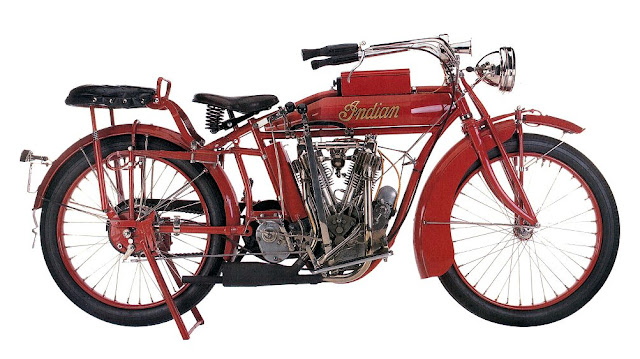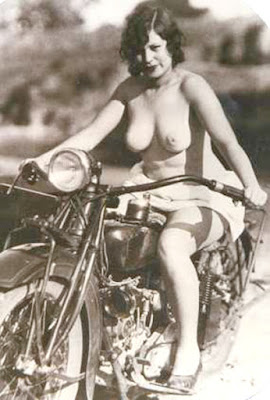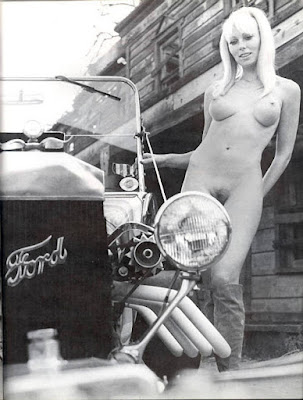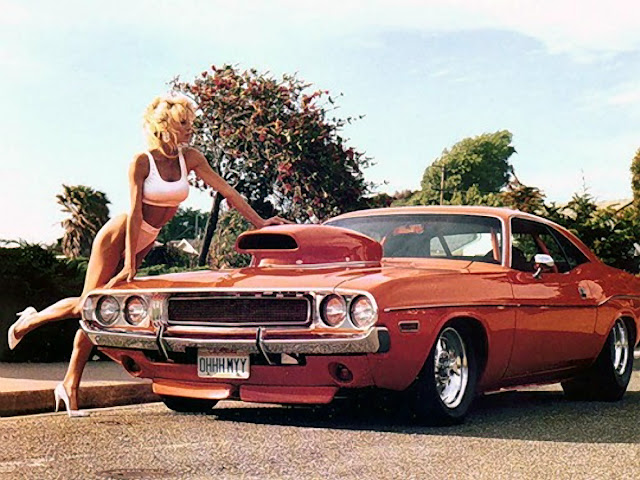 George M. Hendee (1866 - 1943) took up bicycle racing at age 16; in 1886 he won the United
States National Amateur High Wheel Championship, setting a new
world record over a dirt half-mile track of 2 minutes 27.4 seconds which he
held until 1892. In fact, during his racing career Hendee entered 309 races and won 307 of them.
George M. Hendee (1866 - 1943) took up bicycle racing at age 16; in 1886 he won the United
States National Amateur High Wheel Championship, setting a new
world record over a dirt half-mile track of 2 minutes 27.4 seconds which he
held until 1892. In fact, during his racing career Hendee entered 309 races and won 307 of them.When he did stop racing at the age of 26 he threw his energies into designing and building bicycles: in 1895 he opened a shop in Springfield, Massachusetts to produce his "Silver King" bicycles and a year later he took on Edward E. Nelson as a partner, registering the Hendee & Nelson Manufacturing Company. The partnership lasted only two years, leaving Hendee with the entire inventory. The Hendee Manufacturing Company was incorporated in 1898 with a capital stock of $5,000; in an effort to distance himself from the earlier business problems he abandoned the Silver King and Silver Queen model names, rebranding the entire bicycle line to Indian.
Hendee sponsored a number of bicycle racers and events throughout New England, and during one such event in Madison Square Garden in January 1900 he met engineer Carl Oscar Hedström who had been designing motorized pacing bicycles.
Early pacers were tandem bicycles which ran ahead of the racers to split the air stream and lessen wind resistance, possibly the first application of the science of aerodynamics in racing. The problem was that even with two riders, early pacers were so heavy that racers quickly passed them: Hedström's design utilized a lighter bicycle frame fitted with a small gasoline engine to add extra horsepower to the riders' own power. The idea had been tried before, but the motorized pacers of that time functioned poorly and Hedström's design quickly gained a reputation for reliability.
 |
| 1901 Indian "F" head single |
Hendee asked Hedström to bring one of his pacers to Springfield, and the two signed a partnership agreement in January 1901 with Hedstrom taking the title of chief engineer and designer. The first running prototype for Indian, a 1.75 horsepower single with a then-revolutionary chain drive, was built in under six months.
Hedström traveled to Aurora, IL to refine his engine design and the company originally contracted the Aurora Automatic Machine Company to build the engines. Hedström supervised all aspects of manufacturing as well as the expansion of their own factories in Massachusetts (the main factory on State Street was now accompanied by a forging factory in East Springfield). Hendee meanwhile traveled extensively to set up dealerships and arrange financing for the new model. The first Indian "motocycles" (an archaic word denoting any horseless carriage: Hendee used it to distinguish them from the competition) went on sale to the public in 1902. In 1903 Hedström set the world motorcycle speed record (56 mph) and the Springfield factory produced 377 bikes; by 1904 production was up to almost 600 and Hedström turned his attention to a V-twin design.
 |
| 1907 Indian V-twin, 633 hp. |
By 1907 the fledgling sport of motorcycle racing was beginning to develop a serious following. While Hedström worked to improve his carburetors and design new high performance mechanical valves, two of the most influential contests of the 20th century were being planned: an annual Tourist Trophy event on the Isle of Man (Isle of Man TT), and The English 1000 Mile Reliability Trial (which would later evolve into today's International 6 Day's Trial). Although the Isle of Man TT would elude them until 1911, Teddy Hastings took the first 1000 Mile Reliability Trial with a stock Indian V-twin and he did it again in 1908 with the factory's support.
Within two years Boardtrack speeds were pushing 80mph (see my previous article on The Wall of Death) and Indian completely dropped the old diamond frame design for a sturdier loop frame which could support the stresses of racing machines. Just short of 5,000 motorcycles left the factory that year and by 1910 annual production was up to 6,000. Indian was rapidly becoming the largest motorcycle manufacturer in the world.
 |
| 1908 1000cc Racer |
By 1913 Indian was turning out almost 32,000 machines a year, but all was not well with the company. Hendee and Hedström began to disagree on the designs and marketing. Jake DeRosier, who had been close to Hedström during his racing years, was fired by Hendee in 1911; he died from surgical complications after a vicious crash while racing for Excelsior in 1913, and perhaps under some misplaced guilt over his friends' death Carl Hedström turned in his resignation. Within two years Hendee himself retired and in 1915 the company came under control of an investment group.
 | |
| 1915 Big Twin 1000cc |
Facing the drop in domestic sales Springfield began construction of two new lightweight models, a two stroke Model K and an opposed twin Model O but both fell flat: American riders simply weren't interested in smaller bikes. Indian continued on the racing circuit which was revived after the end of the war: Gene Walker took four of the nine dirt track championship events of 1919 and 14 of the national title events in 1920. But despite their successes on the tracks Franklin needed a new heavy design to lure the public away from Harley. His answer was the 1920 middleweight Scout at 600cc., which was followed in 1923 by the iconic Chief.
 |
| 600cc. Scout |
 |
| 1200cc Big Chief |
The lightweight Scout handled far better that the older Powerplus (now renamed as the Standard), and was an immediate hit especially on the dirt tracks. The Chief also gained an appreciative audience and it's big sidevalve engine rapidly gained popularity with the nation's police departments. Franklin kept hoping for a hit in the lightweight market and introduced the 350cc Prince in 1925, but it met the same fate as their other smaller bikes and only saw a production run of three years.
In 1926 Indian bought out the defunct Ace Motorcycle Company, which had been producing a big 4 cylinder machine. The post-war economy was improving, and Indian needed something different to compete with Excelsior's new 750 twin: the answer was a revamped 750cc 101 Scout which they developed at the same time as they tinkered with their now rebranded Ace Four machines. 1929 saw both bikes coming off the factory lines, along with a limited run of OHV Scouts designed specifically for hill climbs. Although the Scouts did well, the Indian Four was only marginally profitable due in part to its $445 price tag (on the verge of the Great Depression, although they didn't know it) and also simply because the monster engines had a limited appeal to the average rider. By 1930 the depression was coming in full force, and the company was sold to Paul DuPont after several chaotic shifts in management groups and investors. DuPont quickly and surprisingly killed the 101 Scout for a couple of years, but the trick worked and by the time a new Model 203 Scout hit the market in 1932 the company had eliminated their deficit and were finally turning a profit again.
 |
| Indian Four |
Despite their low demand, Indian continued to develop the Four. While earlier (and later) Fours had inlet-over-exhaust (IOE) cylinder heads 1936-1937 saw a redesign with the positions reversed. This improved fuel vaporization, and the new engine was more powerful but the new system made the cylinder head -and the rider's crotch- uncomfortably hot. Coupled with an exhaust valve that required frequent adjustment, riders shunned the machine; introduction of dual carburetors in 1937 didn't help, and the design was returned to the original configuration in 1938.
With the advent of the US involvement in the Second World War Indian again geared up for military production, but although the army contracted small numbers of Scouts, Chefs and even Junior Scouts the Harley Davidson WLA won out as their primary military model: in fact the military put most of their resources into the Jeep and motorcycles played a relatively small part in the US war effort. Notably the army was looking for a reliable desert motorcycle and both Harley and Indian prototyped models based on the BMW-R71 which was proving itself on the Russian Front (see Irbit & Kiev: the Dnepr and Ural Motorcycles). Indian produced 1,000 Model 841 bikes with a 750vv transverse twin and shaft drive: Harley responded with the XA model 750 which used a horizontal V like the R-71. The Army passed on both designs.
In 1945 a group headed by Ralph B. Rogers purchased a controlling interest of the company, and on November 1 DuPont formally turned over the reins. Rogers misguidedly discontinued the Scout and Chief, turning to the manufacture of lightweight motorcycles such as the 149 Arrow, the Super Scout 249 and the 250 Warrior, all of which gained an immediate reputation for poor quality and a lack of development. In 1950 Rogers began to focus on importing British bikes and took on an English investor, John Brockhouse. Brockhouse quickly booted Rogers out of the company and split it into two divisions, manufacturing and marketing. The Chief came back into production, but it had lost it's competitive edge to Harley: like Rogers, Brockhouse was more interested in marketing British bikes than manufacturing Indians. Splintered, disgraced and humiliated, the last of the Chiefs came off the line in 1953 and the Springfield factory went under: Brockhouse began importing Royal Enfields, mildly customized them and rebranding them as Indians from 1955 to 1960 (see Royal Enfield: Made Like a Gun).
No conversation on the Indian brand would be complete without mention of Burt Munro, who probably did as much to promote the brand as anyone in the company (albeit indirectly).
Herbert James 'Burt' Munro (25 March 1899 – 6 January 1978) was born in Invercargill, New Zealand. His interest in speed began at a young age and he became a professional speedway rider, rising to the top of the New Zealand motorcycle scene. His 1920 Indian Scout was the 627th to leave the American factory with an original top speed of 55 mph; Munro began modifications in 1926, often making parts himself and by its final stages the Indian's displacement was 950cc with a triple chain drive system.
Munro travelled to Bonneville ten times, the first for "sightseeing" purposes. In the other nine visits he went for it, setting world records in 1962 (178.971 mph, Flying One Mile Class S-A 883 cc), 1966 (168.066 mph, Flying One Mile Class S-A 1000 cc) and 1967 (183.586 mph, Flying One Mile Class S-A 1000 cc). On one unofficial run he clocked 190.07 mph.
Munro's efforts are the basis of the motion picture The World's Fastest Indian (2005) and an earlier 1971 short documentary film Burt Munro: Offerings to the God of Speed. He was inducted into the AMA Motorcycle Hall of Fame in 2006.
above: "Burt" Munro in his workshop, circa 1970
 |
| The Munro Special in Invercargill, prior to Bonneville |
 |
| The Munro Indian about 1926 |
For the next four decades Indian went through what can only be described as a clusterfuck of legal wranglings, rebranded machines and general abuse. Entrepreneur Floyd Clymer began using the Indian name in the 1960s -apparently without license- attaching it to Italian Minarelli engined 50 cc minibikes (the short lived Indian Papoose). Clymer also commissioned 200 motorcycles based on the Italjet Grifon but fitted with Royal Enfield Interceptor 750 cc parallel-twin engines. Clymer died in 1970 leaving the batch of engines stranded at the dock, and rather than going into "Indians" they wound up as the famous Rickman Interceptors.
Clymer's widow "sold" the alleged Indian trademark to Los Angeles attorney Alan Newman, who continued to import minibikes. But by 1975 sales were dwindling and in January 1977, that company was declared bankrupt: the rights to the Indian brand passed through a succession of owners and became a subject of competing claims in the 1980s.
In December 1998 a Federal bankruptcy court awarded the Indian trademark to The Indian Motorcycle Company of America, which had been formed from the merger of the California Motorcycle Company (CMC) and IMCOA Licensing America Inc. along with 7 other companies. The new company began manufacturing motorcycles in 1999 at the former CMC's facilities in Gilroy, California. The first "Gilroy Indian" model was a new design called the Chief: Scout and Spirit models were introduced 2001. These bikes were initially made with off the shelf S&S engines, but the 100-cubic-inch (1,600cc) Powerplus engine design came in on their last year. They went into bankruptcy and crashed in 2003.
On July 20, 2006 London-based private equity firm Stellican Limited formed a new version of the Indian Motorcycle Company: the 2009 Indian Chief incorporated a redesigned 105-cubic-inch (1,720 cc) Powerplus V-twin powertrain with electronic closed-loop sequential-port fuel injection.
In April 2011 Polaris bought Indian from Stellican, and currently the company produces 3 versions of the Chief.
When anyone considers the history of motorcycle manufacturer in the USA, two brands will always stand out: The Indian and Harley Davidson. Harley weathered its own turbulent past of course, and the brand has -to some extent- always managed to rebound.
Indian was not so fortunate; probably due more to poor business decisions than inferior mechanics. Although it remains an icon of American motorcycle tradition it has by no means achieved a solid and enduring future. One hopes that Polaris will change that, but regardless of what happens on the assembly line today there are thousands of trustworthy machines born in Springfield that are still on the road. That in itself is a testimony to the brand.
References:
The Illustrated Directory of Classic American Motorcycles
(ISBN: 0760310505 / 0-7603-1050-5 ) - Tod Rafferty
Indian Motorcycles - official site
Burt Munro - A New Zealand Legend














































